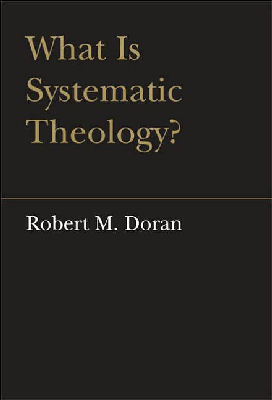
|
Posted June 6, 2006
Book: What is Systematic Theology? Author: Robert M. Doran University of Toronto Press. 2005. Pp.253 An Excerpt from the Jacket:
Doran begins by accepting four emphases presented by Lonergan concerning systematics: first, that its principal function is the hypothetical and analogical understanding of the mysteries of faith; second, that it should begin with those mysteries of faith that have received dogmatic status; third, that it must proceed in the 'order of teaching' rather than the 'order of discovery'; and last, that it must be explanatory rather than merely descriptive. He then replies to the questions that are raised by each of these emphases. What is Systematic Theology? Is the most thorough attempt thus undertaken to advance Lonergan's program for systematics, fully in the spirit of his work but addressing issues that he left to others. Doran's idea of a core set of meanings for systematics - or a 'unified field structure' - is highly original, as is the integration of the systematic ideal and contemporary historical consciousness. An Excerpt from the Book: Out of the Augustinian, Anselmian, Thomist tradition, despite an intervening heavy overlay of conceptualism, the first Vatican council retrieved the notion of understanding. It taught that reason illuminated by faith, when it inquires diligently, piously, soberly, can with God's help attain a highly fruitful understanding of the mysteries of faith both from the analogy of what it naturally knows and from the interconnection of the mysteries with one another and with man's last end. The promotion of such an understanding of the mysteries we conceive to be the principal function of systematics. Perhaps a clarification by contrast will be helpful. Let us compare this emphasis of Lonergan's with the procedures followed by Wolfhart Pannenberg in his Systematic Theology. Pannenberg conceives truth as coherence. This is an idealist conception of truth entailing a less than adequate distinction between insight and judgment. Within such a conception there is no ground for distinguishing doctrines from systematics, for there is no acknowledgment of judgment as a distinct constitutive element in human knowing. On Lonergan's account doctrines are correlated with judgment, systematics with understanding. Doctrines with affirmations. Systematics attempts to understand what has been affirmed. The affirmations are reached in other ways than by systematic argumentation. On Pannenberg's account doctrines and systematics are one, because on his account judgment judgment and understanding are one; as in all idealisms, they are not adequately distinguished. Thus we have the title of the first chapter of Pannenberg's Systematic Theology: 'The Truth of Christian Doctrine as the Theme of Systematic Theology: 'The Truth of Christian Doctrine as the Theme of Systematic Theology.' On Lonergan's account, again, affirming Christian doctrine, not its truth, that is 'the theme of systematic theology.' It is 'how it can be true' that is at stake in systematics. That it is true is already affirmed. Or, to be more precise, by the time the theologian begins to do systematics, he or she has already determined precisely what are the doctrines that are to be affirmed. These may or may not be completely coincident with the official doctrines of a particular communion, but the point is that systematics is an attempt on the part of the theologian to state as clearly as possible the meaning of what one has already affirmed to be the case. And at this point, we are concerned with the principal function of systematics, namely, the understanding of the mysteries of faith affirmed in church doctrines. The truth of doctrine pertains to the functional specialty 'doctrines,' while the meaning of what has already been affirmed as true is the concern of systematics. To affirm certain statements as true and to attempt to understand what these statements entail distinct sets of operations. The first set of operations Lonergan calls 'doctrines', and the second 'systematics.' in Lonergan's words, people 'know what church doctrines are. But they want to know what church doctrines could possibly mean. Their question is the question to be met by systematic theology. Table of Contents: 1. The Question 2. The principal function of systematics and the issues this raises 3. Dogma and mystery 4. Theological doctrines 5. Categories 6. Mediation 7. Structure 8. Anticipations 9. The question of ground 10. System and history |
|
